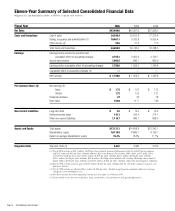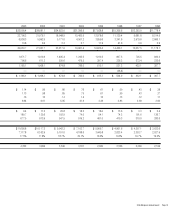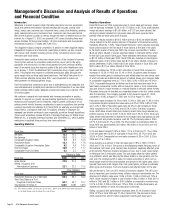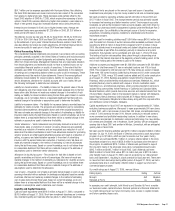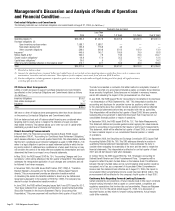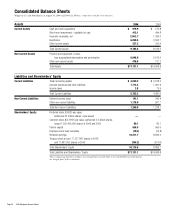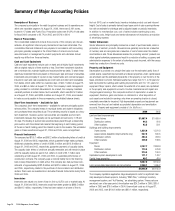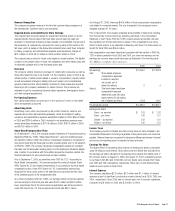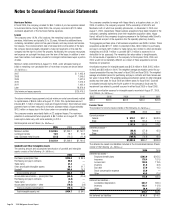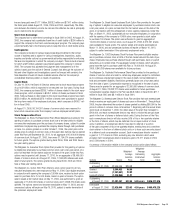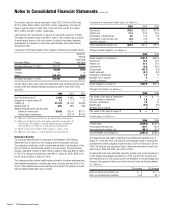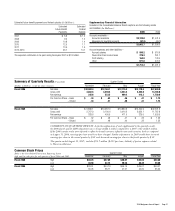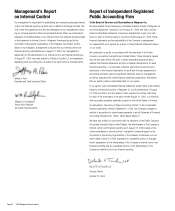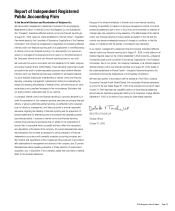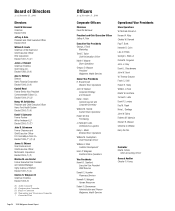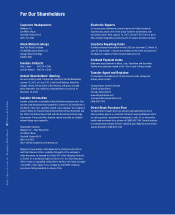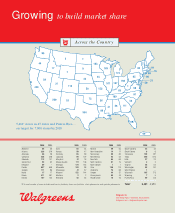Walgreens 2006 Annual Report Download - page 29
Download and view the complete annual report
Please find page 29 of the 2006 Walgreens annual report below. You can navigate through the pages in the report by either clicking on the pages listed below, or by using the keyword search tool below to find specific information within the annual report.
2006 Walgreens Annual Report Page 27
As of August 31, 2006, there was $46.9 million of total unrecognized compensation
cost related to nonvested awards. This cost is expected to be recognized over a
weighted average of 1.56 years.
Prior to fiscal 2006, the company presented all tax benefits of deductions resulting
from the exercise of stock options as operating cash flows in the Consolidated
Statement of Cash Flows. SFAS No.123(R) requires excess tax benefits, the cash
flow resulting from the tax deductions in excess of the compensation cost recog-
nized for those options, to be classified as financing cash flows. The total excess tax
benefit for fiscal 2006 was $56.5 million.
Had compensation costs been determined consistent with the method of SFAS No.
123 for options granted in fiscal 2005 and 2004, pro forma net earnings and net
earnings per common share would have been as illustrated in the following table
(In Millions, except per share amounts):
2005 2004
Net earnings $1,559.5 $1,349.8
Add: Stock-based employee
compensation expenses
included in reported
net income, net of
related tax effects .2 .4
Deduct: Total stock-based employee
compensation expense
determined under fair value
based method for all awards,
net of related tax effects (72.5) (44.1)
Pro forma net income $1,487.2 $1,306.1
Earnings per share:
Basic – as reported $ 1.53 $ 1.32
Basic – pro forma 1.46 1.27
Diluted – as reported 1.52 1.31
Diluted – pro forma 1.45 1.27
Income Taxes
The company provides for federal and state income taxes on items included in the
Consolidated Statements of Earnings regardless of the period when such taxes are
payable. Deferred taxes are recognized for temporary differences between financial
and income tax reporting based on enacted tax laws and rates.
Earnings Per Share
The dilutive effect of outstanding stock options on earnings per share is calculated
using the treasury stock method. Stock options are anti-dilutive and excluded from
the earnings per share calculation if the exercise price exceeds the market price of
the common shares. At August 31, 2006, and August 31, 2004, outstanding options
to purchase 3,505,834 and 2,902,996 common shares were excluded from fiscal
year 2006 and 2004 calculations, respectively. There were no anti-dilutive shares
related to stock options in fiscal 2005.
Interest Expense
The company capitalized $3.3 million, $4.2 million and $1.1 million of interest
expense as part of significant construction projects during fiscal 2006, 2005 and
2004, respectively. Fiscal 2006 had no interest paid, net of amounts capitalized,
compared to $.8 million in 2005 and $.2 million in 2004.
Revenue Recognition
The company recognizes revenue at the time the customer takes possession of
the merchandise. Customer returns are immaterial.
Impaired Assets and Liabilities for Store Closings
The company tests long-lived assets for impairment whenever events or circum-
stances indicate. Store locations that have been open at least five years are
reviewed for impairment indicators at least annually. Once identified, the amount of
the impairment is computed by comparing the carrying value of the assets to the
fair value, which is based on the discounted estimated future cash flows. Included
in selling, occupancy and administration expense were impairment charges of
$22.1 million in 2006, $14.5 million in 2005 and $9.2 million in 2004.
The company also provides for future costs related to closed locations. The liability
is based on the present value of future rent obligations and other related costs (net
of estimated sublease rent) to the first lease option date.
Insurance
The company obtains insurance coverage for catastrophic exposures as well as
those risks required by law to be insured. It is the company’s policy to retain a sig-
nificant portion of certain losses related to workers’ compensation; property losses,
as well as business interruption relating from such losses; and comprehensive
general, pharmacist and vehicle liability. Provisions for these losses are recorded
based upon the company’s estimates for claims incurred. The provisions are
estimated in part by considering historical claims experience, demographic factors
and other actuarial assumptions.
Pre-Opening Expenses
Non-capital expenditures incurred prior to the opening of a new or remodeled
store are expensed as incurred.
Advertising Costs
Advertising costs, which are reduced by the portion funded by vendors, are
expensed as incurred. Net advertising expenses, which are included in selling,
occupancy and administration expense, were $306.9 million in 2006, $260.3 million
in 2005 and $230.9 million in 2004. Included in net advertising expenses were
vendor advertising allowances of $174.8 million in 2006, $180.2 million in 2005
and $163.6 million in 2004.
Stock-Based Compensation Plans
As of September 1, 2005, the company adopted Statement of Financial Accounting
Standards (SFAS) No.123(R), “Share-Based Payment,” using the modified prospec-
tive transition method. Under this method, compensation expense is recognized for
new grants beginning this fiscal year and any unvested grants prior to the adoption
of SFAS No.123(R). The company recognizes compensation expense on a straight-
line basis over the employee’s vesting period or to the employee’s retirement eligible
date, if earlier. In accordance with the modified prospective transition method, the
financial statements for prior periods have not been restated.
Prior to September 1, 2005, as permitted under SFAS No.123, “Accounting for
Stock-Based Compensation,” the company applied Accounting Principles Board
(APB) Opinion No. 25 and related interpretations in accounting for its stock-based
compensation plans. Under APB Opinion No. 25, compensation expense was
recognized for stock option grants if the exercise price was below the fair value
of the underlying stock at the measurement date.
As a result of adopting SFAS No.123(R), our earnings before income tax expense
and net earnings for the fiscal year-end were $102.5 million and $59.3 million
lower, respectively, than if the stock-based compensation was still accounted for
under APB Opinion No. 25. The recognized tax benefit was $36.7 million.



